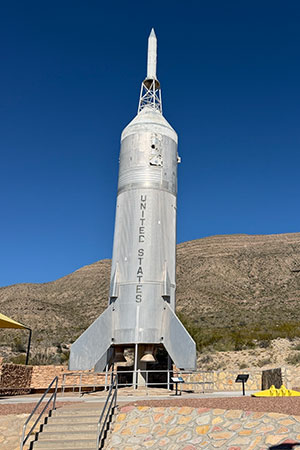November 14, 2025 — A rare surviving example of a NASA rocket that was used to test the first spacecraft to fly astronauts to the moon is being restored 60 years after its last use.
A Little Joe II booster is being returned to its like-new appearance at the New Mexico Museum of Space History in Alamogordo. Between 1963 and 1966, NASA flew five Little Joe II test flights to certify that the Apollo command module could survive an in-flight abort during its climb into space.
"The New Mexico Museum of Space History is thrilled to share that we're refurbishing the shining star of our Rocket Park, Little Joe II! This restoration will bring it back to its original glory," the museum announced on Thursday (Nov. 13).
Working in collaboration with Blast Off, Inc., an Alabama-based aircraft restoration company, and the Smithsonian as the owner of the rocket, the work to restore the Little Joe II is being done in full sight of the public visiting the museum (the Rocket Park and a nearby playground have been temporarily closed).
Originally delivered to the state-run museum in 1985, the Little Joe II is one of only two examples still in existence (the other is on display at the George W.S. Abbey Rocket Park at NASA's Johnson Space Center in Houston, Texas). The rocket in Alamogordo is built up from components that were left over at the end of the test program topped by a boilerplate Apollo capsule and launch escape system tower.
"The escape system [used] in Apollo was very similar in concept to the one used in Project Mercury. However, the Saturn V [rocket] was a much bigger bomb, and the Apollo command module was a larger and heavier spacecraft than the tiny Mercury capsule. This required an escape system that was much more powerful and sophisticated than anything yet designed and flown. It was a system that would have to be thoroughly tested before Apollo could be man-rated," said Tony Gondola, the former outreach coordinator at the New Mexico Museum of Space History, in a 2020 video about the rocket on display.
"That brings us to one of the most impressive artifacts you'll see at the Museum of Space History, our Little Joe II," he said. "Some of that [testing] work took place right here in southern New Mexico, specifically at Launch Complex 36 at the White Sands Missile Range."
At 86 feet tall (26 meters), the Little Joe II was the smallest of the four vehicles that carried the Apollo command module. NASA engineer Max Faget named the vehicle (and its Project Mercury predecessor) after the resemblance between the rocket's four fins and the "Little Joe" roll in the dice game "craps" (a hard four or two twos).
The restoration will fortify the Little Joe II for its display well into the future, said its curator, Brianna Buller, in an interview with collectSPACE.
"Overall, it's in pretty okay condition. We're in an arid climate, so the metal is holding up, however it's a rocket from the 1960s, so anything over time is going to need work," she said. "It's the upper portions of the rocket that have the most deterioration, the most rust. The top is also where all of the birds are getting in, so the abort section is where most of the work is needed."
The holes that have allowed the birds inside the rocket will be patched and bird mesh is being installed. The wooden support beams the formed a skeleton for the empty rocket's display will be replaced by stainless steel.
The boilerplate capsule will also be repainted to more closely match the black and white roll pattern that the Little Joe II flown capsules sported.
"We got the specs from the Smithsonian. We're trying to be as historically accurate as possible," said Buller.
The goal is to complete the work before the end of the year, but the pace will be subject to the weather. The museum has set aside up to 90 days for the project.
The Little Joe II is the first rocket to be refurbished by Blast Off, despite its name. The company has previously restored the NASA KC-135 "Weightless Wonder" astronaut training aircraft on display at Ellington Air and Space Port in Houston and artifacts at the Cape Canaveral Space Force Museum and National Museum of Naval Aviation in Florida, among others.
The New Mexico Museum of Space History, which is a division of the state's Department of Cultural Affairs and a Smithsonian Affiliate, focuses on the role that the state had in the development of the U.S. space program, as well as hosts the international Space Hall of Fame. |
|

The Little Joe II rocket at the New Mexico Museum of Space history in Alamogordo in its current state, prior to its restoration (NMMSH)

An Apollo command module boilerplate launches on a Little Joe II in-flight abort test on December 8, 1964. The third of five Little Joe II tests, the abort mimicked the conditions atop a Saturn V. (NASA)

The Little Joe II rocket is the highlight of the outdoor exhibits at the New Mexico Museum of Space History in Alamogordo. (NMMSH) |
